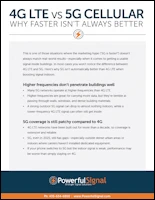Knowledge Base
4G LTE vs. 5G cellular: Why faster isn’t always better
This is one of those situations where the marketing hype (“5G is faster!”) doesn’t always match real-world results—especially when it comes to getting a usable signal inside buildings. In most cases you won’t notice the difference between 4G LTE and 5G. Here’s why 5G isn’t automatically better than 4G LTE when boosting signal indoors:
Higher frequencies don’t penetrate buildings well
- Many 5G networks operate at higher frequencies than 4G LTE.
- Higher frequencies are great for carrying more data, but they’re terrible at passing through walls, windows, and dense building materials.
- A strong outdoor 5G signal can drop to almost nothing indoors, while a lower-frequency 4G LTE signal can often still get inside.
5G coverage is still patchy compared to 4G
- 4G LTE networks have been built out for more than a decade, so coverage is extensive and reliable.
- 5G, even in 2025, still has gaps—especially outside dense urban areas or indoors where carriers haven’t installed dedicated equipment.
- If your phone switches to 5G but the indoor signal is weak, performance may be worse than simply staying on 4G.
Cellular boosters are optimized for LTE first
- Most consumer and commercial cellular boosters are designed primarily to amplify low- and mid-band frequencies (the ones used heavily by 4G LTE).
- While some newer boosters support 5G bands, many 5G frequencies—especially mmWave—cannot be effectively boosted with standard hardware.
- In many real deployments, boosting LTE delivers more consistent results because the signal is easier to capture and amplify.
Your phone may get “stuck” on weak 5G
- Phones are programmed to prefer 5G if it’s available—even if that 5G signal is weak.
- This can cause slower data speeds and dropped calls compared to forcing the phone to stay on strong LTE.
- In weak-signal areas, LTE often provides better real-world performance.
Indoors, reliability usually matters more than peak speed
- 5G shines in open-air environments or venues with dedicated 5G systems, where it can deliver lightning-fast speeds.
- But for voice calls, text messaging, and everyday apps, a solid LTE connection is usually more important than chasing top-end 5G speeds.
- A properly installed LTE booster can often fix dead zones more effectively than a very expensive 5G solution which requires carrier approval and separate carrier specific amplifiers.
Bottom line: 5G isn’t “bad,” but it’s not automatically better indoors. Because LTE uses lower frequencies with better building penetration and is easier to boost with existing hardware, improving LTE often gives the most dependable results.


